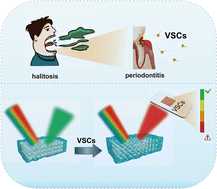A structural color hydrogel for diagnosis of halitosis and screening of periodontitis†
Abstract
Oral pathogens can produce volatile sulfur compounds (VSCs), which is the main reason for halitosis and indicates the risk of periodontitis. High-sensitivity detection of exhaled VSCs is urgently desired for promoting the point-of-care testing (POCT) of halitosis and screening of periodontitis. However, current detection methods often require bulky and costly instruments, as well as professional training, making them impractical for widespread detection. Here, a structural color hydrogel for naked-eye detection of exhaled VSCs is presented. VSCs can reduce disulfide bonds within the network, leading to expansion of the hydrogel and thus change of the structural color. A linear detection range of 0–1 ppm with a detection limit of 61 ppb can be achieved, covering the typical VSC concentration in the breath of patients with periodontitis. Furthermore, visual and in situ monitoring of Porphyromonas gingivalis responsible for periodontitis can be realized. By integrating the hydrogels into a sensor array, the oral health conditions of patients with halitosis can be evaluated and distinguished, offering risk assessment of periodontitis. Combined with a smartphone capable of color analysis, POCT of VSCs can be achieved, providing an approach for the monitoring of halitosis and screening of periodontitis.



 Please wait while we load your content...
Please wait while we load your content...